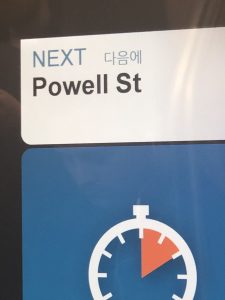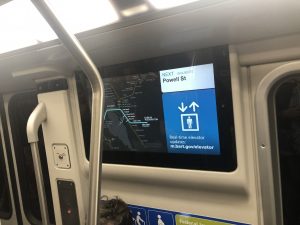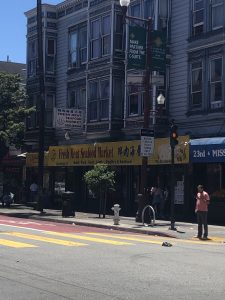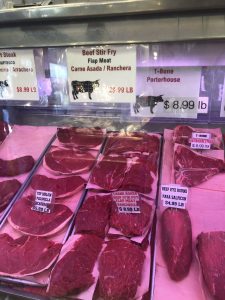San Francisco is a bustling city filled with people from all parts of the world. San Francisco boasts the largest Chinatown outside of Asia. In a 2009-2013 census, 40.4% of the participants said they spoke a language different from English at home. The people of San Francisco are bringing the languages around the world to this city, however the government officials ruling this city are slow to adapt to the residents of this city. In a city with so many different cultures melting into a small 46.89 square miles, San Francisco’s population is incredibly multilingual, however the official signage on streets, maps, public transit ways, and government-regulated signs remain in English.
The BART (Bay Area Rapid Transit) connects most of the Bay area from Oakland to Berkeley to Richmond and of course San Francisco. On one given weekday, January 19 of 2019 for example, there were approximately 395,860 riders alone. Aside from the BART, public transportation in San Francisco is widely used and well connected with over 21 different public transportation services available. I have ridden public transportation everyday for the past month and only have ridden the new BART trains once out of an approximate 65 rides. These new trains have automated screens displaying the upcoming station, the word “next” has smaller translations in 4 different languages, Chinese, Korean, Vietnamese, and Spanish. Interestingly the top 4 languages spoken other than English in a census from 2009-2013, are Spanish, Chinese, Tagalog, and Vietnamese. While these new screens are a step in the right direction towards a multilingual city, they aren’t fully implemented on the subway system, on all types of public transportation, nor translate any important information such as stop names or directions. Aside from these baby steps, I wasn’t able to find any variation in language in any government-issued signs.


Korean label on BART train
The residents of San Francisco recognize the multilingual landscape and that’s why businesses and restaurants often have different languages on signs. The Missions District is a prominent Spanish-speaking area. When I was in the Missions District, I noticed a Chinese butcher shop and was intrigued because I assumed that most of the surrounding area couldn’t read Chinese. When I entered I noticed that aside from the meat, all the side products such as condiments or prepared foods were Chinese or Mexican companies. On the signs for the meat itself, underneath the English label there were Spanish labels. I noticed that a customer and an employee of the establishment were having an interaction entirely in Spanish. I spoke to the employees in Mandarin. This shop, like many others around this city, remained true to their identity as a Chinese-owned establishment, yet adapted to the environment they were in and realized that they needed to use Spanish to attract the consumers of the area. The placement of English on the signs served as universal baseline to guarantee that no matter what language you natively speak, there was a way to convey the information needed. English was used not because it reflected the linguistic landscape of the Missions District, not because the owners of the establishment use it, but because it is the official language of the country.


Leeman and Modan identify political, social, economic factors to makeup the linguistic landscape of a city. While San Francisco’s political powers haven’t recognized the multilingual landscape, the social and economic powers of the people and business owners have and have changed the signs as well as the use of spoken language to reflect that.
Works Cited
“GCT-PH1 – Population, Housing Units, Area, and Density: 2010 – County – Census Tract”. 2010 United States Census Summary File 1. United States Census Bureau. Retrieved June 27, 2019.
Leeman, J & Modan, G. (2009), Commodified language in Chinatown: a contextualized
approach to a linguistic landscape. Journal of Sociolinguistics, 13(3), 332-362.
“Ridership Reports.” Bay Area Rapid Transit, www.bart.gov/about/reports/ridership.
US Census Bureau. “Detailed Languages Spoken at Home and Ability to Speak English.” Detailed Languages Spoken at Home and Ability to Speak English, 28 Oct. 2015, www.census.gov/data/tables/2013/demo/2009-2013-lang-tables.html.
Hey Elizabeth! I thought that your comment about how the BART system included four languages (Chinese, Korean, Vietnamese, and Spanish) but the top 4 languages of the city were Spanish, Chinese, Tagalog, and Vietnamese was very interesting. I cannot understand why the BART System would not use Tagalog instead of Korean in its rail system, as this would allow for more accessibility. I think you are right when you say that this is an important step forward, even despite the fact that it does not completely represent the populations it is trying to support. I also liked how you ended the article with a reflection on Leeman and Modan. The economic sector seems to be very vital to linguistic landscapes, as oftentimes the main reason for language diversity is to accomodate and attract potential profits. I am glad that owners could use this to their advantage, as this means local businesses recognize the efforts they need to make in order to stay afloat. Overall, it was a great article with some interesting points!
Great article on the multilingual linguistic landscape of San Francisco! Signages of Korean in the BART, as well as those of Chinese and Spanish really shows that San Francisco’s linguistic landscape consists not totally of English. The use of these non-English languages plays an important role in attracting customers and contributes to the development of the city. Nice pictures!
Hi Elizabeth! So fascinating to hear about your experiences in the multilingual linguistic landscape of San Francisco. It’s interesting that you described English as a “universal baseline” for understanding, though census numbers show this trending away. It’s so incredible that you are able to spend your summer in such a diverse area rich in all types of languages, and it’s so different than my experience in Dublin. Everyone uses English here, and the government really only regulates Irish translations onto street signs and on public transport. I really enjoyed reading your piece and seeing the pictures you included, hope you’re having a great summer!
Elizabeth — As I am also living in San Francisco, I totally agree with your analysis on the lack of multilingual signs on public transportation systems. I thought it was especially interesting that the BART system does not use Tagalong in its new trains despite its high ranking on the list of most spoken languages in San Francisco. I think this shows the government’s tendency to use more well known languages rather than languages that are the most spoken.